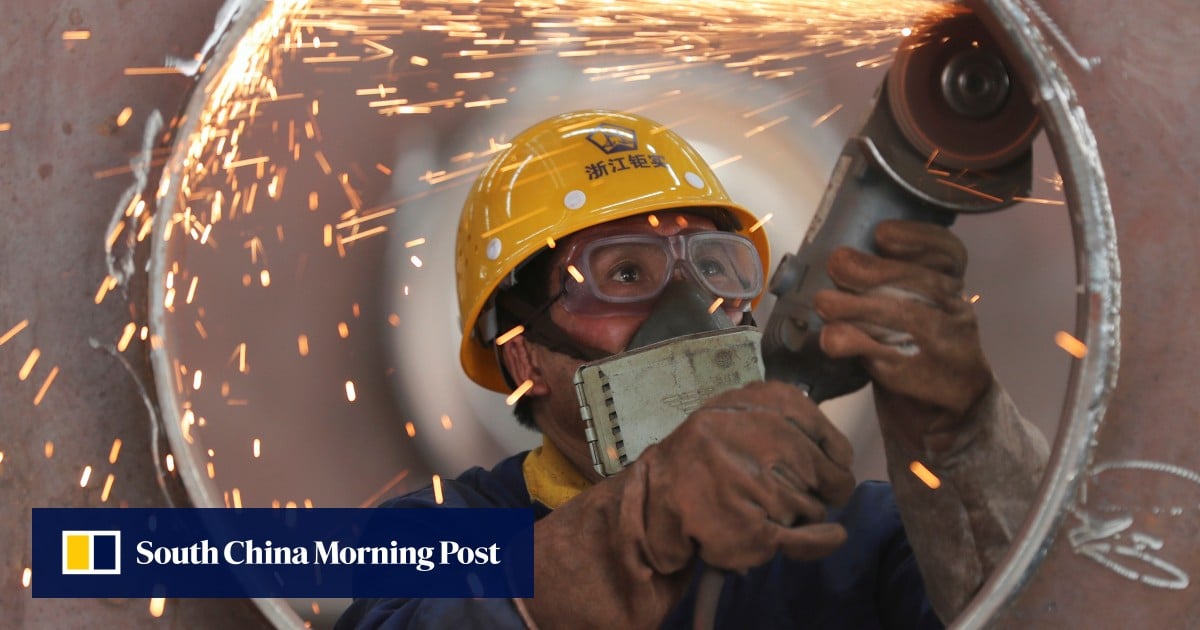Falling Iron Ore Prices: A Result Of Reduced Chinese Steel Production

Table of Contents
China's Reduced Steel Production: The Core Issue
China's steel industry, once a powerhouse driving global demand for iron ore, is undergoing a significant transformation. This reduction in production is the primary catalyst for the falling iron ore prices we're witnessing.
Government Regulations and Environmental Concerns
China's unwavering commitment to environmental protection and carbon emission reduction is reshaping its industrial landscape. Stricter regulations are directly impacting steel production:
- Increased scrutiny on illegal steel mills: The government's crackdown on unlicensed and environmentally damaging steel mills has significantly reduced overall output.
- Stringent emission control measures impacting output: New emission standards and stricter enforcement are forcing steel mills to either upgrade their facilities (a costly endeavor) or reduce production.
- Government targets for carbon neutrality influencing production quotas: China's ambitious carbon neutrality goals are leading to tighter production quotas for steel, impacting the overall supply. This is a long-term strategy with significant implications for iron ore demand.
Weakening Real Estate Sector and Construction Activity
The slowdown in China's once-booming real estate sector is another critical factor. The construction industry, a massive consumer of steel, is experiencing a significant downturn:
- Decreased demand for construction materials like steel rebar and structural steel: Fewer new buildings translate directly to lower demand for steel products.
- Impact of property market regulation on steel consumption: Government policies aimed at cooling the overheated property market have inadvertently reduced construction activity and, consequently, steel demand.
- Delayed and cancelled construction projects leading to surplus steel capacity: Numerous projects have been delayed or cancelled, leading to a significant surplus of steel in the market, further depressing prices.
Global Economic Slowdown and Reduced Global Demand
The global economic slowdown is compounding the issue, further weakening demand for steel and, consequently, iron ore:
- Impact of inflation and recessionary pressures on global infrastructure projects: High inflation and the threat of recession have led to cuts in infrastructure spending globally, reducing demand for steel.
- Reduced demand from other major steel-consuming nations: Even outside China, decreased economic activity in many countries is impacting steel consumption.
- Increased competition from recycled steel and alternative materials: The growing use of recycled steel and the exploration of alternative construction materials are adding to the pressure on traditional steel production.
Impact on Iron Ore Prices and Market Dynamics
The reduced demand for steel is directly impacting iron ore prices, leading to significant market volatility.
Price Volatility and Market Fluctuations
The correlation between steel production and iron ore prices is undeniable. Recent months have witnessed sharp price declines:
- Analysis of iron ore price trends in recent months: Charts clearly show a downward trend in iron ore prices mirroring the reduction in Chinese steel production.
- Comparison with historical price fluctuations: This current decline is significant compared to historical fluctuations, highlighting the severity of the situation.
- Predicting future price movements based on current trends: Predicting the future is challenging, but understanding the current trends is crucial for informed decision-making.
Impact on Major Iron Ore Producers
Falling iron ore prices are severely impacting major producers, particularly in Australia and Brazil:
- Analysis of the financial performance of major iron ore mining companies: Many companies are experiencing reduced profitability and are taking measures to cut costs.
- Strategies adopted by companies to mitigate price drops: Producers are implementing various strategies, including reducing production, exploring cost-cutting measures, and hedging against price fluctuations.
- Potential for mergers and acquisitions in the industry: The challenging market environment might lead to consolidation within the industry through mergers and acquisitions.
Future Outlook and Predictions for Iron Ore Prices
Predicting the future of iron ore prices requires considering several factors.
Potential for Price Recovery
Several factors could trigger a price recovery:
- Increased infrastructure spending in other countries: A global surge in infrastructure investment could lead to increased steel demand, boosting iron ore prices.
- A rebound in the Chinese real estate market: A revival of the Chinese construction sector would significantly impact iron ore demand.
Long-Term Trends and Sustainability Concerns
The long-term outlook involves considering sustainability:
- Increased use of recycled steel: The growing focus on recycling and sustainable practices could impact the demand for newly mined iron ore.
- Alternative materials: Continued development and adoption of alternative construction materials could further reduce the long-term reliance on steel.
Investment Strategies and Risk Management
Navigating the iron ore market requires careful consideration:
- Diversification: Investors should diversify their portfolios to mitigate the risks associated with price volatility.
- Hedging strategies: Utilizing hedging tools can help protect against potential price drops.
Conclusion
The decline in Chinese steel production is the primary driver of falling iron ore prices. The interplay of government regulations, economic slowdown, and decreased construction activity has created a challenging market environment. While a price recovery is possible, understanding the long-term trends and sustainability concerns within the steel and iron ore industries is crucial. Closely monitoring falling iron ore prices and understanding the underlying factors influencing the market is vital for making informed decisions. Stay informed to navigate the complexities of this dynamic commodity sector and adapt your investment and business strategies accordingly.

Featured Posts
-
 Update On Jayson Tatums Wrist What The Celtics Coach Said
May 09, 2025
Update On Jayson Tatums Wrist What The Celtics Coach Said
May 09, 2025 -
 Joint Effort Pakistan Sri Lanka And Bangladesh Enhance Capital Market Integration
May 09, 2025
Joint Effort Pakistan Sri Lanka And Bangladesh Enhance Capital Market Integration
May 09, 2025 -
 Snls Impression Of Harry Styles The Singers Disappointed Response
May 09, 2025
Snls Impression Of Harry Styles The Singers Disappointed Response
May 09, 2025 -
 High Potential David Uncovering Morgans Biggest Vulnerability
May 09, 2025
High Potential David Uncovering Morgans Biggest Vulnerability
May 09, 2025 -
 Thailands Central Bank New Governor Needed To Navigate Tariff Challenges
May 09, 2025
Thailands Central Bank New Governor Needed To Navigate Tariff Challenges
May 09, 2025
